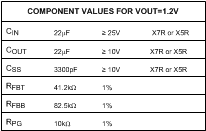SNVS853E August 2012 – August 2018 LMZ21701
PRODUCTION DATA.
- 1 Features
- 2 Applications
- 3 Description
- 4 Revision History
- 5 Pin Configuration and Functions
- 6 Specifications
- 7 Detailed Description
- 8 Application and Implementation
- 9 Power Supply Recommendations
- 10Layout
- 11Device and Documentation Support
- 12Mechanical, Packaging, and Orderable Information
Package Options
Refer to the PDF data sheet for device specific package drawings
Mechanical Data (Package|Pins)
- SIL|8
Thermal pad, mechanical data (Package|Pins)
Orderable Information
8.2 Typical Application
For a quick start, the following component values can be used as a design starting point for several typical output voltage rails and 1 A of output load current.
 Figure 14. Typical Applications Circuit
Figure 14. Typical Applications Circuit  Figure 16. External Component Values
Figure 16. External Component Values
( VOUT = 1.8 V )
 Figure 18. External Component Values
Figure 18. External Component Values
( VOUT = 3.3 V )
 Figure 15. External Component Values
Figure 15. External Component Values
( VOUT = 1.2 V )
 Figure 17. External Component Values
Figure 17. External Component Values
( VOUT = 2.5 V )
 Figure 19. External Component Values
Figure 19. External Component Values
( VOUT = 5.0 V )